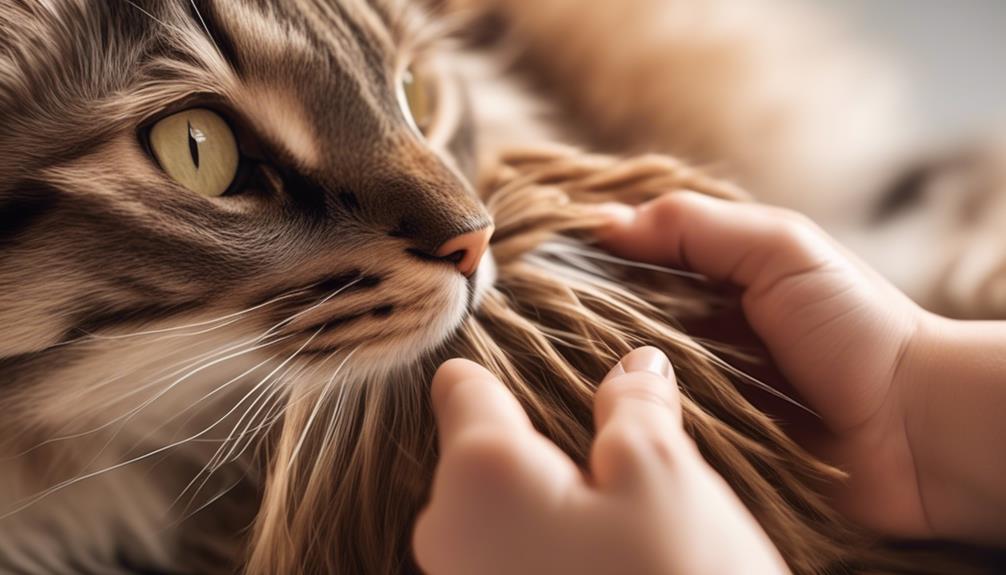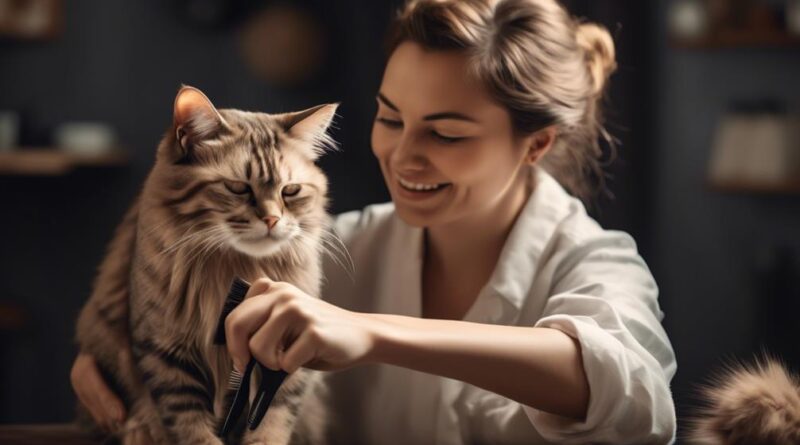11 Essential Tips for Grooming Your Cat
So, you've noticed that your cat's coat is looking a little unkempt lately, and you're wondering how to properly groom your feline friend. Grooming your cat is not only essential for their physical health but also for their emotional well-being.
With the right approach and techniques, grooming can be a bonding experience for both you and your cat. In this guide, we'll explore 11 essential tips that will help you navigate the world of feline grooming with confidence and ease.
Whether you're a seasoned cat owner or a newbie to the feline care game, these tips will ensure that your cat's grooming routine is a stress-free and enjoyable experience for both of you.
Understanding Your Cat's Behavior
Do you know why your cat behaves the way it does? Understanding your cat's behavior is essential for building trust and rapport with your feline friend. One of the key aspects of understanding your cat is interpreting their body language.
Cats communicate through their body movements, and by paying attention to their signals, you can better comprehend their moods and needs. When your cat approaches you with a straight posture and raised tail, it signifies friendliness and a desire for interaction. On the other hand, a lowered or puffed-up tail indicates fear or aggression.
By recognizing these cues, you can adjust your approach to meet your cat's emotional state, thus building trust and strengthening your bond. Building trust and rapport with your cat also involves respecting their boundaries. While some cats enjoy being held and cuddled, others prefer their personal space.
Creating a Calm Environment
Understanding your cat's behavior is the foundation for creating a calm environment that fosters their well-being and contentment. Cats thrive in soothing atmospheres, so it's essential to build trust with your cat and create a peaceful space for grooming.
To establish a tranquil setting, start by designating a quiet and comfortable area for grooming sessions. This could be a specific room or corner where your cat feels secure and relaxed. Consider using soft blankets or cushions to make the space inviting.
Creating a soothing atmosphere also involves minimizing potential stressors. Reduce loud noises and sudden movements during grooming, as these can startle your cat and lead to anxiety. Additionally, ensure that the grooming tools are within reach and easily accessible. This will prevent unnecessary disruptions during the grooming process, allowing your cat to stay calm and composed.
Building trust with your cat is crucial for grooming in a calm environment. Take the time to bond with your cat outside of grooming sessions. Engage in playtime, provide affection, and offer treats to strengthen your relationship. By doing so, your cat will associate grooming with positive experiences and feel more at ease during the grooming process.
Using the Right Tools
To ensure effective grooming, select the appropriate tools that are specifically designed for your cat's coat type and grooming needs. Grooming frequency is an important factor to consider when choosing the right tools. For long-haired cats, daily brushing is essential to prevent mats and tangles, so a slicker brush and wide-toothed comb are recommended. Short-haired cats may only need to be brushed a few times a week, so a soft bristle brush or rubber grooming mitt would suffice. When selecting tools, it's crucial to consider your cat's comfort and the effectiveness of the tool on their specific coat.
Tool maintenance is another key aspect to keep in mind. After each grooming session, ensure that all tools are cleaned and properly stored. This not only increases the longevity of the tools but also prevents the transfer of dirt or potential skin issues from one grooming session to the next. Regularly inspect your tools for any signs of wear and tear, such as broken bristles or dull blades, and replace them as needed. Proper maintenance ensures that your grooming tools remain effective and safe for your cat.
In addition, it's important to consider your cat's individual preferences when choosing grooming tools. Some cats may prefer a gentle massage with a grooming glove, while others may find the sensation of a bristle brush more soothing. By observing your cat's reactions during grooming sessions, you can tailor your choice of tools to their comfort and enjoyment.
Handling Your Cat With Care
When tending to your cat's grooming needs, it's crucial to handle them with care to ensure their comfort and safety. Understanding your cat's body language is essential in ensuring a positive grooming experience. Cats communicate their emotions and comfort levels through their body language, and being attuned to these cues can help you handle them with care. Signs of distress may include flattened ears, dilated pupils, or a swishing tail. Conversely, relaxed body language such as slow blinking or a gently swaying tail indicates that your cat is comfortable and at ease.
When it comes to gentle restraint techniques, it's important to approach your cat calmly and with a soothing voice. If your cat becomes agitated during grooming, consider using gentle restraint techniques to ensure their safety and prevent them from escaping. One effective technique is to gently hold your cat's scruff, the loose skin at the back of their neck, which mimics the way a mother cat would carry her kittens. However, it's crucial to use this method with caution and only for short periods, as prolonged scruffing can cause discomfort.
Brushing Techniques
Ensure your cat's comfort and cleanliness by using the right brushing techniques to maintain their coat. Proper handling and gentle strokes are essential for a pleasant grooming experience for both you and your feline friend. Here are three key brushing techniques to keep in mind:
- Proper Holding: When brushing your cat, make sure to hold them gently but securely. Cats can be sensitive to being restrained, so it's important to handle them with care. Start by placing one hand under their chest for support and use the other hand to brush their fur. This will help your cat feel more at ease during the grooming process.
- Gentle Strokes: Use gentle and slow strokes when brushing your cat's coat. Begin at the head and work your way down to the tail, following the direction of their fur growth. Be especially cautious around sensitive areas such as the belly and hindquarters. If your cat becomes agitated, take a break and try again later to avoid causing them distress.
- Regular Schedule: Establish a regular brushing schedule to maintain your cat's coat. Depending on your cat's breed and coat length, brushing every 2-3 days may be necessary. This will help prevent matting and reduce shedding, keeping your cat's fur in top condition.
Trimming Nails Safely
Keeping your cat's nails trimmed is an important part of their grooming routine to ensure their comfort and safety. Nail trimming not only prevents your cat from getting their nails snagged in carpets or furniture but also reduces the risk of accidental scratches to you and your family members. However, cats can be sensitive about their paws, so it's crucial to approach nail trimming with care and patience.
Understanding cat behavior is essential for safely trimming their nails. Start by getting your cat accustomed to having their paws handled. Gently massage their paws and reward them with treats to create a positive association.
When it's time to trim the nails, choose a quiet and comfortable place. Hold your cat securely but gently, and use specialized cat nail clippers to trim the tips of the nails. Be cautious not to cut into the quick, a sensitive blood vessel inside the nail, which can cause bleeding and discomfort.
If your cat becomes agitated or stressed, take a break and try again later. Some cats may resist nail trimming initially, but with consistent and gentle practice, most cats can learn to tolerate it. If you're unsure about how to trim your cat's nails, consider seeking guidance from a professional groomer or veterinarian.
Dealing With Mats and Tangles

To maintain your cat's overall grooming routine, it's important to address the issue of dealing with mats and tangles, which can cause discomfort and skin irritation if left unattended. Here are some essential tips for preventing mats and detangling fur:
- Regular Brushing: Brush your cat's fur regularly, especially if they have long hair. Use a comb or brush designed for your cat's fur type. This helps to prevent mats from forming by removing loose hair and preventing it from tangling.
- Use Detangling Spray: If you notice a small mat forming, apply a detangling spray to the affected area. Gently work through the mat with your fingers or a comb, starting from the outside and working your way in. This will help to loosen the mat without causing discomfort to your cat.
- Professional Grooming: If your cat's fur is prone to matting, consider taking them to a professional groomer for regular maintenance. Professional groomers have the expertise and tools to effectively remove mats and tangles without causing distress to your cat.
Rewarding Your Cat After Grooming
After grooming your cat, consider rewarding them with a special treat or some extra playtime to create a positive association with the grooming process. Rewarding your cat after grooming is essential for building trust and reinforcing positive behavior. Cats respond well to positive reinforcement, and associating grooming with a pleasant experience will make future grooming sessions easier for both you and your feline friend.
When selecting a treat, choose something your cat loves and doesn't get often, such as a small piece of cooked chicken or a favorite cat treat. The key is to make the reward special and something your cat will look forward to after each grooming session. By doing this, you're creating a positive link between grooming and a delightful reward.
In addition to treats, you can also reward your cat with extra playtime. Engaging in interactive play with your cat after grooming not only reinforces the positive experience but also helps to release any tension your cat may have felt during the grooming process. It's a great way to reassure your cat and strengthen your bond.
Frequently Asked Questions
How Can I Train My Cat to Enjoy Grooming Sessions?
To train your cat to enjoy grooming, use positive reinforcement and desensitization. Gradually introduce grooming tools while rewarding good behavior. With patience and behavior modification, your cat can learn to see grooming as a positive experience.
What Are Some Signs That My Cat May Be Experiencing Discomfort During Grooming?
If your cat shows signs of discomfort during grooming, such as hissing, growling, or swatting, it may indicate pain or stress. Watch for changes in behavior, like aggression or avoidance, as these can signal discomfort during grooming.
Are There Any Specific Grooming Techniques for Different Cat Breeds?
When grooming Persian cats, use a stainless-steel comb to remove tangles and mats. For Siamese cats, a rubber brush works well to reduce shedding. Tailor grooming techniques to your cat's breed for best results.
How Often Should I Groom My Cat, and Are There Any Seasonal Considerations?
You should groom your cat regularly to prevent matting and reduce shedding around the house. During shedding seasons, increase grooming frequency to manage loose fur. Brushing and combing can be especially helpful during these times.
What Are Some Alternative Grooming Methods for Cats Who Are Particularly Sensitive or Anxious?
To help a sensitive or anxious cat with grooming, try calming techniques and desensitization methods. Use gentle handling and positive reinforcement. Gradually introduce grooming tools, and always be patient and understanding.
Conclusion
Now that you have learned these essential tips for grooming your cat, you can create a calm and comfortable environment for them.
Using the right tools and handling your cat with care will make the grooming process easier for both of you.
Remember to reward your cat after grooming to make it a positive experience.
With these tips, you can keep your cat looking and feeling their best while strengthening your bond with them.
